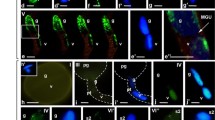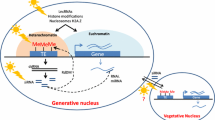Key message
Improving pollen embryogenesis.
Abstract
Despite the agro-economic importance of pollen embryogenesis, the mechanisms underlying this process are still poorly understood. We describe the dynamics of chromatin modifications (histones H3K4me2, H3K9ac, H3K9me2, and H3K27me3) and chromatin marks (RNA polymerase II CDC phospho-Ser5, and CENH3) during barley pollen embryogenesis. Immunolabeling results show that, in reaction to stress, immature pollen rapidly starts reorganizing several important chromatin modifications indicative of a change in cell fate. This new chromatin modification pattern was accomplished within 24 h from whereon it remained unaltered during subsequent mitotic activity. This indicates that cell fate transition, the central element of pollen embryogenesis, is completed early on during the induction process. Application of the histone deacetylase inhibitor trichostatin A stimulated pollen embryogenesis when used on pollen with a gametophytic style chromatin pattern. However, when this drug was administered to embryogenic pollen, the chromatin markers reversed toward a gametophytic profile, embryogenesis was halted and all pollen invariably died.







Similar content being viewed by others
References
Blais A, van Oevelen CJ, Margueron R, Acosta-Alvear D, Dynlacht BD (2007) Retinoblastoma tumor suppressor protein-dependent methylation of histone H3 lysine 27 is associated with irreversible cell cycle exit. J Cell Biol 179:1399–1412
Blank T, Trendelenburg M, Kleinschmidt J (1992) Reactivation of DNA replication in erythrocyte nuclei by Xenopus egg extract involves energy-dependent chromatin decondensation and changes in histone phosphorylation. Exp Cell Res 202:224–232
Borkird C, Choi JH, Jin ZH, Franz G, Hatzopoulos P, Chorneau R, Bonas U, Pelegri F, Sung ZR (1988) Developmental regulation of embryonic genes in plants. Dev Biol 85:6399–6403
Braszewska-Zalewska AJ, Wolny EA, Smialek L, Hasterok R (2013) Tissue-specific epigenetic modifications in root apical meristem cells of Hordeum vulgare. PLoS ONE 8(7):e69204
Brownell JE, Allis CD (1996) Special HATs for special occasions: linking histone acetylation to chromatin assembly and gene activation. Curr Opin Genet Dev 6:176–184
Coronado M-J, Hensel G, Broeders S, Otto I, Kumlehn J (2005) Immature pollen-derived doubled haploid formation in barley cv. Golden Promise as a tool for transgene recombination. Acta Physiol Plant 27:591–599
Daghma DS (2011) Structural changes during the initiation of pollen embryogenesis in barley (Hordeum vulgare L.). Dissertation, Martin-Luther-University Halle-Wittenberg, Germany
Daghma DS, Kumlehn J, Hensel G, Rutten T, Melzer M (2012) Time-lapse imaging of the initiation of pollen embryogenesis in barley (Hordeum vulgare L.). J Exp Bot 63:6017–6021
Daghma DS, Hensel G, Rutten T, Melzer M, Kumlehn J (2014) Cellular dynamics during early pollen embryogenesis revealed by time-lapse imaging. Front Plant Sci. doi:10.3389/fpls.2014.00675
Drew MC (1997) Oxygen deficiency and root metabolism: injury and acclimation under hypoxia and anoxia. Annu Rev Plant Phys 48:223–250
Dunwell JM (2010) Haploids in flowering plants: origins and exploitation. Plant Biotechnol J 8:377–424
Gao L, Cueto MA, Asselbergs F, Atadja P (2002) Cloning and functional characterization of HDAC11, a novel member of the human histone deacetylase family. J Biol Chem 277:25748–25755
Grafi G (2004) How cells dedifferentiate: a lesson from plants. Dev Biol 268:1–6
Hoekstra S, van Zijderveld MH, Louwerse JD, Heidekamp F, van der Mark F (1992) Anther and Microspore culture of Hordeum vulgare L. cv. Igri. Plant Sci 86:89–96
Houben A, Kumke K, Nagaki K, Hause G (2011) CENH3 distribution and differential chromatin modifications during pollen development in rye (Secale cereale L.). Chrom Res 19:471–480
Indrianto A, Heberle-Bors E, Touarev A (1999) Assessment of various stresses and carbohydrates for their effect on the induction of embryogenesis in isolated wheat microspores. Plant Sci 143:71–79
Karantzali K, Schulz H, Hummel O, Hubner N, Hatzopoulos AK, Kretsovali K (2008) Histone deacetylase inhibition accelerates the early events of stem cell differentiation: transcriptomic and epigenetic analysis. Genome Biol 9:R65
Kemp MG, Ghosh M, Liu G, Leffak M (2005) The histone deacetylase inhibitor trichostatin A alters the pattern of DNA replication origin activity in human cells. Nucleic Acids Res 33:325–336
Kinoshita T, Seki M (2014) Epigenetic memory for stress response and adaptation in plants. Plant Cell Physiol 55:1859–1863
Kumlehn J, Serazetdinova L, Hensel G, Becker D, Loerz H (2006) Genetic transformation of barley (Hordeum vulgare L.) via infection of androgenetic pollen cultures with Agrobacterium tumefaciens. Plant Biotechnol J 4:251–261
Laskey RA, Mills AD, Morris NR (1977) Assembly of SV40 chromatin in a cell-free system from Xenopus eggs. Cell 10:237–243
Lee JH, Hart SRL, Skalnik DG (2004) Histone deacetylase activity is required for embryonic stem cell differentiation. Genesis 38:32–38
Li Y, Butenko Y, Grafi G (2005) Histone deacetylation is required for progression through mitosis in tobacco cells. Plant J 41:346–352
Li H, Soriano M, Cordewener J, Muiño JM, Riksen T, Fukuoka H, Angenent GC, Boutilier K (2014) The histone deacetylase inhibitor Trichostatin A promotes totipotency in the male gametophyte. Plant Cell 113:116491
Liang G, Zhang G (2013) Embryonic stem cell and induced pluripotent stem cell: an epigenetic perspective. Cell Res 23:49–69
Liao CT, Lin CH (2001) Physiological adaptation of crop plants to flooding stress. Proc Natl Sci Counc ROC 25:148–157
Lienert F, Mohn F, Tiwari VK, Baubec T, Roloff TC, Gaidatzis D, Stadler MB, Schübeler D (2011) Genomic prevalence of heterochromatic H3K9me2 and transcription do not discriminate pluripotent from terminally differentiated cells. PLoS Genet 7:e1002090
Ma J, Wing A, Bennetzen JL, Jackson SA (2007) Plant centromere organization: a dynamic structure with conserved functions. Trends Genet 23:134–139
Maalouf WE, Liu Z, Brochard V, Renard JP, Debey P, Beaujean N, Zink D (2009) Trichostatin A treatment of cloned mouse embryos improves constitutive heterochromatin remodeling as well as developmental potential to term. BMC Dev Biol 9:11
McCool KW, Xu X, Singer DB, Murdoch FE, Fritsch MK (2007) The role of histone acetylation in regulating early gene expression patterns during early embryonic stem cell differentiation. J Biol Chem 282:6696–6706
Miguel C, Marum L (2011) An epigenetic view of plant cells cultured in vitro: somaclonal variation and beyond. J Exp Bot 62:3715–3725
Murphy JP, McAleer JP, Uglialoro A, Papile J, Weniger J, Bethelmie F, Tramontano WA (2000) Histone deacetylase inhibitors and cell proliferation in pea root meristems. Phytochemistry 55:11–18
Oh HJ, Lee TH, Lee BC (2012) Trichostatin A improves preimplantation development of bovine cloned embryos and alters expression of epigenetic and pluripotency genes in cloned blastocysts. J Vet Med Sci 74:1409–1415
Pandey P, Houben A, Kumlehn J, Melzer M, Rutten T (2013) Chromatin alterations during pollen development in Hordeum vulgare. Getogenet Genome Res 141:50–57
Parthun MR, Widom J, Gottschling DE (1996) The major cytoplasmic histone acetyltransferase in yeast: links to chromatin replication and histone metabolism. Cell 87:85–94
Pechan PM, Smykal P (2001) Androgenesis: affecting the fate of the male gametophyte. Physiol Plant 111:1–8
Peng H, Zhang J (2009) Plant genomic DNA methylation in response to stresses: potential applications and challenges in plant breeding. Prog Nat Sci 19:1037–1045
Ruiz-Carrillo A, Wangh LJ, Allfrey VG (1975) Processing of newly synthesized histone molecules. Science 190:117–128
Sanei M, Pickering R, Kumke K, Nasuda S, Houben A (2011) Loss of centromeric histone H3 (CENH3) from centromeres precedes uniparental chromosome elimination in interspecific barley hybrids. Proc Natl Acad Sci USA 108:498–505
Schübeler D, MacAlpine DM, Scalzo D, Wirbelauer C, Kooperberg C, van Leeuwen F, Gottschling DE, O’Neill LP, Turner BM, Delrow J, Bell SP, Groudine M (2004) The histone modification pattern of active genes revealed through genome-wide chromatin analysis of a higher eukaryote. Genes Dev 18:1263–1271
Schubert D, Clarenz O, Goodrich J (2005) Epigenetic control of plant development by Polycombgroup proteins. Curr Opin Plant Biol 8:553–561
Seguí-Simarro JM, Nuez F (2008) How microspores transform into haploid embryos: changes associated with embryogenesis induction and microspore-derived embryogenesis. Physiol Plant 134:1–12
Seifert F, Bössow S, Kumlehn J, Gnad H, Scholten S (2016) Analysis of wheat microspore embryogenesis induction by transcriptome and small RNA sequencing using the highly responsive cultivar “Svilena”. BMC Plant Biol 16:97. doi:10.1186/s12870-016-0782-8
Solís M-T, Rodríguez-Serrano M, Meijón M, Cañal M-J, Cifuentes A, Risueño MC, Testillano PS (2012) DNA methylation dynamics and MET1a-like gene expression changes during stress-induced pollen reprogramming to embryogenesis. J Exp Bot 63:6431–6444
Soriano M, Cistué L, Castillo A (2008) Enhanced induction of microspore embryogenesis after n-butanol treatment in wheat (Triticum aestivum L.) anther culture. Plant Cell Rep 27:805–811
Soriano M, Li H, Boutilier K (2013) Microspore embryogenesis: establishment of embryo identity pattern in culture. Plant Reprod 26:181–196
Taranger CK, Noer A, Sørensen AL, Håkelien AM, Boquest AC, Collas P (2005) Induction of dedifferentiation, genomewide transcriptional programming, and epigenetic reprogramming by extracts of carcinoma and embryonic stem cells. Mol Biol Cell 16:5719–5735
Traas JA, Doonan JH, Rawlins D, Shaw PJ, Watts J, Lloyd CW (1987) An actin network is present in the cytoplasm throughout the division cycle of carrot cells: actin co-distributes with the four microtubule arrays. J Cell Biol 105:387–3965
Tsuji H, Saika H, Tsutsumi N, Hirai A, Nakazono M (2006) Dynamic and reversible changes in histone H3-Lys4 methylation and H3 acetylation occurring at submergence inducible genes in rice. Plant Cell Physiol 47:995–1003
Verdin N, Ott M (2015) 50 years of protein acetylation: from gene regulation to epigenetics, metabolism and beyond. Nat Rev Mol Cell Biol 16:258–264
Ware CB, Wang L, Mecham BH, Shen L, Nelson AM, Bar M, Lamba DA, Dauphin DS, Buckingham B, Askari B, Lim R, Tewari M, Gartler SM, Issa JP, Pavlidis P, Duan Z, Blau CA (2009) Histone deacetylase inhibition elicits an evolutionarily conserved self renewal program in embryonic stem cells. Cell Stem Cell 4:359–369
Woodland HR, Adamson ED (1977) The synthesis and storage of histones during the oogenesis of Xenopus laevis. Dev Biol 57:118–135
Wu RS, Kohn KW, Bonner WM (1981) Metabolism of ubiquitinated histones. J Biol Chem 256:5916–5920
Xiang D, Venglat P, Tibiche C, Yang H, Risseeuw E, Cao Y, Babic V, Cloutier M, Keller W, Wang E, Selvaraj G, Datla R (2011) Genome-wide analysis reveals gene expression and metabolic network dynamics during embryo development in Arabidopsis. Plant Physiol 156:346–356
Yadav RK, Perales M, Gruel J, Ohno C, Heisler M, Girke T, Jönsson H, Reddy GV (2013) Plant stem cell maintenance involves direct transcriptional repression of differentiation program. Mol Syst Biol 9:654. doi:10.1038/msb.2013.8
Zentner GE, Henikoff S (2013) Regulation of nucleosome dynamics by histone modifications. Nat Struct Mol Biol 20:259–266
Zheng MY, Liu W, Weng Y, Polle E, Konzak CF (2001) Culture of freshly isolated wheat (Triticum aestisum L.) microspores treated with inducer chemicals. Plant Cell Rep 20:685–690
Acknowledgements
We would like to thank Katrin Kumke, Ingrid Otto and Monika Wiesner for excellent technical support and Dr. Marek Marzec for helpful discussions. The first author was supported by the Siemens/DAAD (Deutscher Akademischer Austauschdienst) postgraduate program with Grant A/11/71982.
Author information
Authors and Affiliations
Corresponding author
Ethics declarations
Conflict of interest
The authors declare that they have no conflict of interest.
Additional information
Communicated by Dolf Weijers.
Rights and permissions
About this article
Cite this article
Pandey, P., Daghma, D.S., Houben, A. et al. Dynamics of post-translationally modified histones during barley pollen embryogenesis in the presence or absence of the epi-drug trichostatin A. Plant Reprod 30, 95–105 (2017). https://doi.org/10.1007/s00497-017-0302-5
Received:
Accepted:
Published:
Issue Date:
DOI: https://doi.org/10.1007/s00497-017-0302-5




